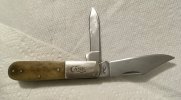hsherzfeld
Gold Member
- Joined
- Mar 10, 2016
- Messages
- 563
My new Case Barlow (62009 1/2) arrived a few days ago with great walk and talk (although I'm not a huge fan of the half-stops). I've just finished dyeing the natural bone scales with leather dye. In the process of which, I opened and closed the blades a lot to flush out excess dye, etc. I did run the knife under hot water in an attempt to make the scales absorb more of the dye. I also used a jeweler's file to slightly round the corners of the tangs that are exposed when the blades are folded, to make the transition from half-stop to full open more smooth. This did not affect the surfaces of the tangs that engage the springs (those surfaces still have the factory toolmarks that they came with).
But now, suddenly, the clip blade is slightly loose in the full-open position and very loose in the full-closed position, so much so that it rattles if I shake the knife while it's closed. It's only solid at the half-stop. It's as if the spring suddenly lost some of its tension and isn't engaging the tang surfaces. Meanwhile, the pen blade is still solid in both positions. I doubt that I can return the knife now that I've dyed the scales.
Any suggestions as to how to fix this issue? Is there a way to re-stiffen the spring?
But now, suddenly, the clip blade is slightly loose in the full-open position and very loose in the full-closed position, so much so that it rattles if I shake the knife while it's closed. It's only solid at the half-stop. It's as if the spring suddenly lost some of its tension and isn't engaging the tang surfaces. Meanwhile, the pen blade is still solid in both positions. I doubt that I can return the knife now that I've dyed the scales.
Any suggestions as to how to fix this issue? Is there a way to re-stiffen the spring?

